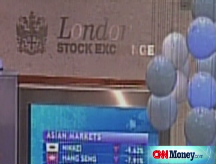Dollar falls after Fed decision
Greenback continues to fall against riskier currencies as U.S. central bank lowers its key interest rate to 1%.
NEW YORK (CNNMoney.com) -- The dollar fell against other currencies Wednesday after the Federal Reserve cut its benchmark interest rate to boost the ailing economy.
The euro bought $1.2853, rising 1.3% from Tuesday's close of $1.2683. At one point on Tuesday, the euro fell as low as $1.2329, which was the lowest level for the 15-nation currency since April 2006.
The British pound gained 2.9% to $1.6310 from $1.5898 late Tuesday. The pound rallied from its lowest level against the dollar since November 2002, set Monday.
The dollar fell 1% against the Japanese yen to ¥96.005 from ¥98.033 late Tuesday. The greenback's fall came a day after it rose 5.7% against the yen, marking its largest one-day rise in 34 years.
In a widely expected move, the Fed lowered its key federal funds rate by half a percentage point to 1% from 1.5%.
While stocks prices in the United States were moderately lower following the central bank's announcement, anticipation of the rate cut boosted Asian markets overnight and supported European shares.
With renewed confidence in the markets, investors shifted funds out of dollars, which have risen lately as investors became averse to risk.
"When there's risk aversion, there's a flight to quality and demand for dollars," said Dustin Reid, senior currency strategist at ABN AMRO. "Demand for dollars ebbs when the opposite is true."
Even though rate cuts tend to weigh on the dollar due to inflation concerns, analysts believe there's a chance that the dollar could come out unscathed this time around.
"It all depends on how stocks react to the news," said Reid. "We're likely to get a very bearish statement from the FOMC, which would likely be bad news for businesses."
Reid anticipates that stocks will fall in the afternoon, and the dollar's recent rise will likely resume.
Currencies have been trading in a theme recently. Turmoil in the world's financial markets and concerns about a global recession have driven investors away from high-yielding currencies such as the euro and the pound.
As a result, lower-yielding currencies like the dollar and the yen have surged in value because they are considered by many investors to be a safe-haven. For instance, even with Tuesday's large rebound, the dollar has still declined 8.6% against the yen since the beginning of the month, when it traded at about ¥106.
With the market searching for a bottom, analysts believe currencies will trade like this for about another half-year before normal trading resumes.
"Trading cycles wax and wane over time, so we will move back to a state where fundamentals are a little more important, most likely at the end of the first quarter in 2009," Reid said. "But that's not going to happen as long as commentary from the Fed and Treasury remains bearish." ![]()



